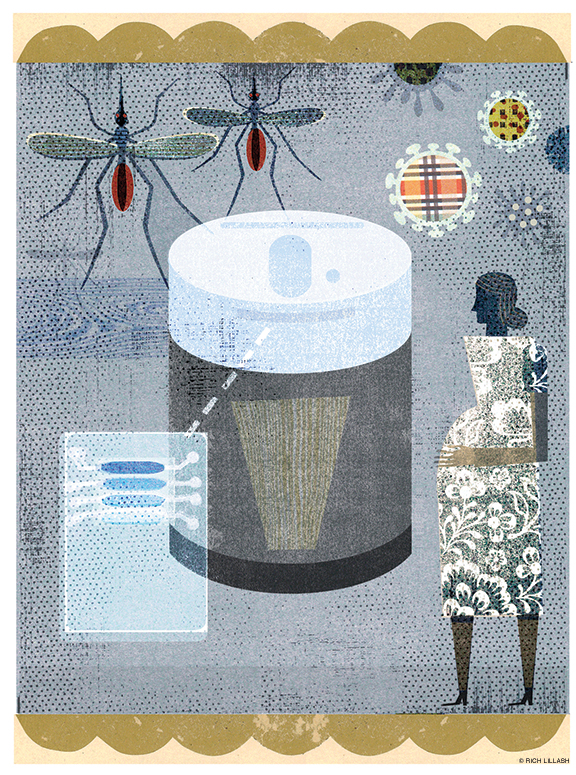
It sounds like a contraption straight out of a MacGyver rerun, or perhaps the mind of a five-year-old with an unusually keen interest in disease control. A small metal thermos—the kind you might use to keep 12 ounces of coffee warm—is packed with a chunk of aluminum, a waxy substance, and one of those self-heating gizmos used to warm up Army meal rations. On top is a small microfluidic chip. Introduce a few drops of saliva, urine, or blood to the chip; squirt a little water into the thermos; and wait 40 minutes. No need for electricity, lab instruments, refrigeration, or even a medical technician. If the chip turns blue, you have the Zika virus.
That’s the prototype of a device developed by Research Assistant Professor Changchun Liu and Professor Haim Bau of the Department of Mechanical Engineering and Applied Mechanics, along with two other members of Bau’s lab, in collaboration with Sara Cherry, an associate professor of microbiology in the Perelman School of Medicine.
Currently, the only approved tests for the devastating virus require specialized laboratory equipment and trained personnel. The Bau lab’s device, made largely from off-the-shelf components, costs about $2 to assemble, and can be deployed in the field under virtually any conditions. What’s more, it identifies actual genetic material from the Zika virus, as opposed to antibodies produced by a person infected with it.
Zika, which has menaced Central and South America and has now been determined to have spread to Florida, is transmitted by mosquitoes and sexual contact. It poses special risks to pregnant women, infecting the fetus and potentially causing severe birth defects, including microcephaly, in which a baby’s head and brain is much smaller than expected. The first US “Zika baby” was born in New Jersey in February, with a deformed head. In July, a study published in Nature Microbiology projected that the 1,674 confirmed global cases of microcephaly associated with Zika could ultimately swell to “tens of thousands” in the epidemic’s “first wave.” CDC Director Thomas Frieden has estimated the lifetime cost of care for a microcephalic baby to be between $1 million and $10 million.
The ability to diagnose the disease in the field, at low cost, may therefore be critical to women of childbearing age.
Like many viruses, Zika is present in bodily fluids, but in quantities too small to detect without amplification. The best established technique to amplify those minute quantities, reverse transcriptase polymerase chain reaction, or PCR, has drawbacks.
“PCR requires cycling of the temperature,” Bau explains. “You have three different temperatures you need to cycle through, which implies a fairly sophisticated and expensive instrumentation.” His team used another method, reverse transcription loop-mediated isothermal amplification, or LAMP, which is carried out at a single temperature—about 60 degrees Celcius. “So the demands on the instrumentation are much more relaxed.”
His team used data-mining techniques to identify regions of the Zika genome that distinguish it from other known pathogens, which they used to create specialized “primers” needed to carry out LAMP. The military-ration heating element, a magnesium alloy, produces heat when combined with water. The thermos insulates the reaction, and the wax-like material sops up excess heat by simply melting. The microfluidic chip, which fits over the aluminum heat sink, is loaded with a dye that changes colors in the presence of the virus. In tests on saliva spiked with Zika, the device showed sensitivity equivalent to PCR. The results were reported in Analytical Chemistry in June.
“The next step is to test it with actual samples” in the field, Bau says. “We have collaborators in Panama, and a proposal pending at NIH.”
The device can be modified to test for a wide range of specific pathogens—and may prove useful in detecting the amount of a virus present in a patient. If the microfluidic chip were loaded with a fluorescent dye rather than a colorimetric one, Bau says, “a cellphone flash can be used to excite the fluorescence, the cellphone camera can monitor the signal, and cellphone software can essentially convert what the camera sees into an intensity signal” which correlates with the viral load.
“In the case of Zika, it’s probably not that critical,” Bau says, “but in the case of HIV, people undergoing therapy are monitoring the viral load, which is very important to determine the course of therapy.” —T.P.




